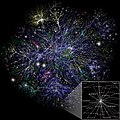the degree of a node in a network is the number of connections it has to other nodes and the degree distribution is the probability distribution of these...
15 KB (2,542 words) - 03:13, 27 December 2024
Barabási–Albert model (section Degree distribution)
scale-free networks, meaning that they have power-law (or scale-free) degree distributions, while random graph models such as the Erdős–Rényi (ER) model and...
21 KB (2,744 words) - 03:34, 4 June 2025
A scale-free network is a network whose degree distribution follows a power law, at least asymptotically. That is, the fraction P(k) of nodes in the network...
47 KB (5,995 words) - 00:15, 6 June 2025
Network science (section Average degree)
\mathbb {E} [\langle k\rangle ]=\mathbb {E} [k]=p(N-1)} . Degree distribution The degree distribution P ( k ) {\displaystyle P(k)} is a fundamental property...
68 KB (9,830 words) - 20:39, 5 July 2025
regular nor purely random. Such features include a heavy tail in the degree distribution, a high clustering coefficient, assortativity or disassortativity...
19 KB (2,448 words) - 15:52, 5 January 2025
Watts–Strogatz model (section Degree distribution)
for the formation of hubs. Formally, the degree distribution of ER graphs converges to a Poisson distribution, rather than a power law observed in many...
11 KB (1,613 words) - 17:30, 19 June 2025
consequently the degree distribution will be enriched at high degree values. This is known colloquially as a fat-tailed distribution. Graphs of very different...
38 KB (4,646 words) - 17:23, 9 June 2025
function corresponding to the excess degree distribution. So, for random Erdős–Rényi networks of average degree ⟨ k ⟩ {\displaystyle \langle k\rangle...
26 KB (3,133 words) - 05:14, 12 April 2025
tree-like random graphs with non-uniform degree distributions P ( k ) {\displaystyle P(k)} . The degree distribution does not define a graph uniquely. However...
10 KB (1,440 words) - 00:34, 20 June 2025
which each subgraph has a vertex of degree at most k. Indegree, outdegree for digraphs Degree distribution Degree sequence for bipartite graphs Diestel...
10 KB (1,276 words) - 13:10, 18 November 2024
networks is the clustering coefficient distribution, which decreases as the node degree increases. This distribution also follows a power law. The Barabási...
66 KB (7,365 words) - 08:57, 4 July 2025
notion of the degree distribution to the spectrum of graphlet degree distributions (GDDs) in the following way. The degree distribution measures the number...
11 KB (1,675 words) - 23:07, 20 February 2025
the distribution of the nodes' clustering coefficients: as other models would predict a constant clustering coefficient as a function of the degree of...
9 KB (1,192 words) - 03:30, 26 March 2024
examination with computer experiments. At a given point of time, degree distribution u ( n ) {\displaystyle u(n)} , is the probability that a randomly...
8 KB (1,196 words) - 11:49, 21 March 2025
undirected graph equals to the degree distribution vector if and only if the graph is regular, i.e., every vertex has the same degree. A generalization of PageRank...
71 KB (8,808 words) - 00:14, 2 June 2025
power-law degree distribution to properly estimate it. However, sampling random friends incorporates more nodes from the tail of the degree distribution (i.e...
26 KB (3,332 words) - 12:10, 24 June 2025
scale-free networks where the degree distribution can be described by a pure power law. However, the degree distribution of most real life networks cannot...
7 KB (1,002 words) - 19:56, 12 October 2024
particular interest of network science. It is characterized by its degree distribution following a power law. While the most widely known generative models...
5 KB (819 words) - 22:43, 17 March 2025
examples are the Rayleigh distribution (chi distribution with two degrees of freedom) and the Maxwell–Boltzmann distribution of the molecular speeds in...
10 KB (1,726 words) - 21:53, 23 November 2024
Interactome (section Degree distribution)
show a scale-free (power law) degree distribution where the connectivity distribution P(k) ~ k−γ with k being the degree. This relationship can also be...
61 KB (6,616 words) - 18:09, 15 April 2025
degree distribution follows a power law function. In some empirical examples this power-law fits the degree distribution well only in the high degree...
5 KB (674 words) - 11:46, 13 September 2024
probability theory, a log-normal (or lognormal) distribution is a continuous probability distribution of a random variable whose logarithm is normally...
90 KB (12,551 words) - 22:45, 22 May 2025
networks with scale-free topology where the in-and out-degree distribution is a power-law distribution: P ( K ) ∝ K − γ {\displaystyle P(K)\propto K^{-\gamma...
25 KB (2,831 words) - 22:14, 7 May 2025
average ( n 2 ) p {\displaystyle {\tbinom {n}{2}}p} edges. The distribution of the degree of any particular vertex is binomial: P ( deg ( v ) = k ) =...
19 KB (2,784 words) - 05:56, 9 April 2025
theory and statistics, a normal distribution or Gaussian distribution is a type of continuous probability distribution for a real-valued random variable...
148 KB (21,531 words) - 03:40, 1 July 2025
g_{1}(z)} is the generating function corresponding to the excess degree distribution. In networks with low clustering, 0 < C ≪ 1 {\displaystyle 0<C\ll...
18 KB (2,377 words) - 23:47, 19 June 2025
statistics, Student's t distribution (or simply the t distribution) t ν {\displaystyle t_{\nu }} is a continuous probability distribution that generalizes the...
55 KB (6,423 words) - 06:46, 1 June 2025
Sparse network (section Node degree distribution)
node degree distribution changes with the increasing connectivity. Different link densities in the complex networks have different node-degree distribution...
7 KB (1,011 words) - 17:04, 4 January 2024
Bianconi–Barabási model (section Degree distribution)
that a node's growth depends on its fitness and can calculate the degree distribution. The Bianconi–Barabási model is named after its inventors Ginestra...
22 KB (3,121 words) - 19:54, 12 October 2024
the degree sequence from specific edge generation processes. This makes it suitable for analyzing networks with heterogeneous degree distributions, such...
30 KB (4,490 words) - 14:49, 18 June 2025
















